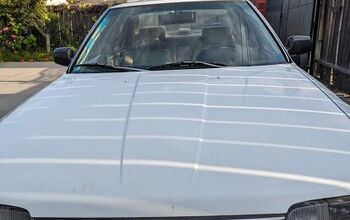Opinion: Subbrands Are A Marketing Failure

Automakers seem to love the idea of subbrands.
The most recent one to make this sort of shift -- Land Rover.
What I can't figure out is: Why?
Put aside, for a second, that Land Rover is retiring, at least for now, a recognizable brand name that presumably has a lot of brand equity. The larger question is -- do consumers even care?
I would wager that they don't -- and that they don't even know.
Here's an example. I was at a recent event where I ran into my local Stellantis PR rep and I cracked a joke about using a "Jeep Wagoneer" for a task. I was politely reminded that there shouldn't be "Jeep" in front of "Wagoneer."
But the thing is, we still call it a Jeep Wagoneer, in part because we're sort of on a case-by-case basis when it comes to indulging weird naming patterns at an OEM's request, and in part because of search optimization.
And it's not just us -- neither Cars.com nor AutoTrader, the two biggest consumer sites, have Wagoneer listed as a brand. Both list Wagoneer as a model under Jeep as a make.
It's a bit like that line from Mean Girls: "Stop Trying to Make Fetch Happen." Stop trying to make subbrands happen.
I haven't tried this experiment yet, but I bet if I talk to friends and say I am driving a Wagoneer without specifying it's a Jeep, at least some folks wouldn't know what it is, or that it's made by Stellantis and sold right next to Jeeps at the dealer.
Similarly, people will know that a Defender is a Land Rover, but if I say "It's a 110, made by Defender" I am gonna get some weird looks.
Heck, Land Rover was already confusing with the "Land Rover Range Rover" nomenclature.
It's one thing to build out a full-on luxury brand the way Toyota did with Lexus. That works, because there's a distinction in styling and the dealerships are separate. But a subbrand just ends up confusing consumers (and sometimes, us) and doesn't really move the needle. It's anecdotal, I know, but I don't hear people talking about the Wagoneer as if it's separate from Jeep. Unless, of course, they work for Stellantis.
The only time subbrands seem to work is with performance vehicles. BMW M, Mercedes-Benz AMG, and Ford's Shelby Mustangs. It seems to work in those cases because cars slapped with those labels are built on cars that aren't part of the subbrand -- M3 on the 3-Series, and so on -- and because most have a history. Then again, the relatively recent use of N for Hyundai works -- again, because N or N-Line models are based on mainstream vehicles, as opposed to the company trying to make an individual model into a subbrand, as Jeep and Land Rover are doing.
I could be wrong. I am no highly-paid marketing consultant. But for now, it sure seems like the subbrand experiment is too confusing to work.
[Image: Land Rover (or is it Defender?)]
Become a TTAC insider. Get the latest news, features, TTAC takes, and everything else that gets to the truth about cars first by subscribing to our newsletter.

Tim Healey grew up around the auto-parts business and has always had a love for cars — his parents joke his first word was “‘Vette”. Despite this, he wanted to pursue a career in sports writing but he ended up falling semi-accidentally into the automotive-journalism industry, first at Consumer Guide Automotive and later at Web2Carz.com. He also worked as an industry analyst at Mintel Group and freelanced for About.com, CarFax, Vehix.com, High Gear Media, Torque News, FutureCar.com, Cars.com, among others, and of course Vertical Scope sites such as AutoGuide.com, Off-Road.com, and HybridCars.com. He’s an urbanite and as such, doesn’t need a daily driver, but if he had one, it would be compact, sporty, and have a manual transmission.
More by Tim Healey
Latest Car Reviews
Read moreLatest Product Reviews
Read moreRecent Comments
- 28-Cars-Later "elections"
- Tassos Good job, Senile, Corrupt Idiot-in-Chief.And when Inflation doubles again under your failed watch, LIE again that it was .. 9% when you took office, while THE REAL inflation then was less than 2%!Disgusting imbecile....
- Wjtinfwb Glad to see Toyota hanging in there with sedans. It's a bit clunky looking but no worse than a new BMW 7-series at 1/3 the price. More power would be nice but Toyota is married to the Hybrid/4-cylinder configuration. As this package gets refined I expect it will be come the norm.
- Wolfwagen The last couple of foreign vehicle manufacturers that tried breaking into the U.S. Mainstream Vehicle Market had a very hard time and 1. Couldn't get past the EPA regulation side (Mahindra) or 2. had a substandard product (Vinfast).
- Midori Mayari I live in a South American country where that is already the case; Chinese brands essentially own the EV market here, and other companies seem unable to crack it even when they offer deep enough discounts that their offerings become cheaper than the Chinese ones (as Renault found when it discounted its cheapest EV to be about 15% cheaper than the BYD Seagull/Dolphin Mini and it still sold almost nothing).What's more, the arrival of the Chinese EVs seem to have turbocharged the EV transition; we went from less than 1% monthly EV market share to about 5% in the span of a year, and it's still growing. And if — as predicted — Chinese EV makers lower their production costs to be lower than those of regular ICE cars in the next few years, they could undercut equivalent ICE car prices with EVs and take most of the car market by storm. After all, a pretty sizeable number of car owners here have a garage where they could charge, and with local fuel and electricity prices charging at home reduces fuel costs by over 80% compared with an ICE car.

































Comments
Join the conversation
Sub-brands don't have value, except when they do. About 25 years ago, Honda saw some market research that their Legend and Integra sub-brands were more recognized by consumers than the Acura name was. Perversely, instead of playing to their strengths, misguided Acura executives responded with an attempt to ram the parent brand down consumers' throats, abolishing the popular sub-brands and naming every model "Acura" followed by meaningless alphabet-soup gibberish.
Predictably, the result was a sales carnage that took years to recover from. In some ways, they arguably never recovered. They've never regained the lost share at the sedan high-end abandoned by the Legend, and they ultimately gave up. And the Integra name retained so much more luster than its alphabet-soup replacements, Acura has just brought it back.
How about what Hyundai did? For model year 2017, Hyundai took the name of their top-line sedan and coupe - "Genesis" - and turned it into a brand on its own. As we can see , in North America, this has worked very well for for them. Chrysler did the same thing with their Imperial luxury cars, and created a top-line brand with that name in 1955. This worked well for them until 1975, when they needed to economize their offerings.